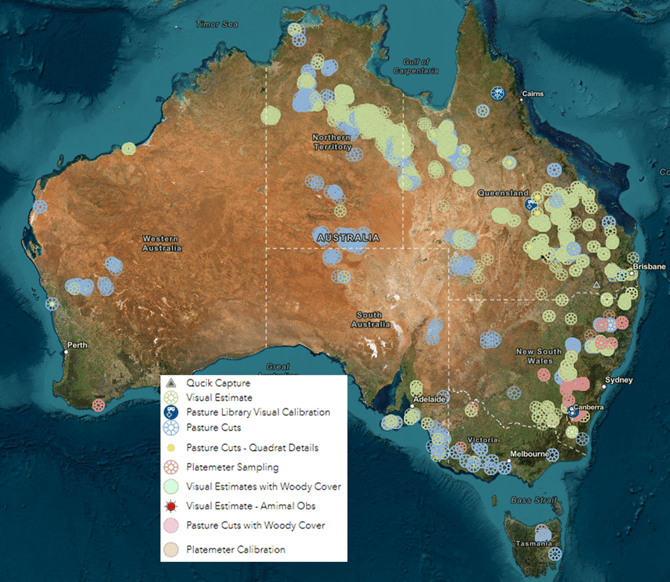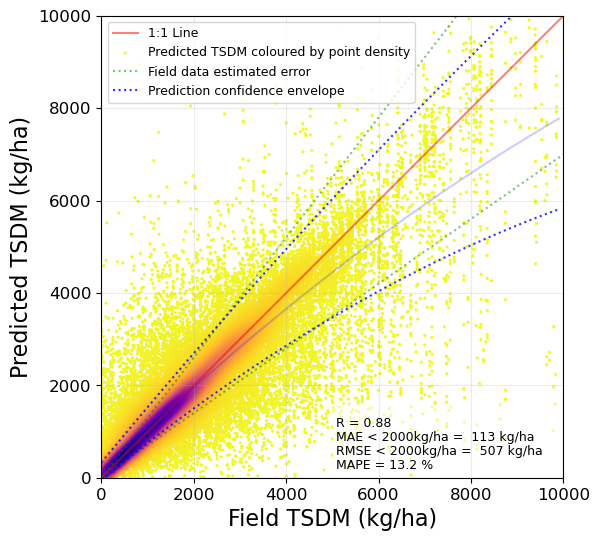Cibo Labs Pasture Biomass Model Update October 2025
On October 8th 2025 we implemented a major update to the Cibo Labs PastureKey service
Since our last release in April 2025, we have been actively collaborating with our clients and partners to improve our Total Standing Dry Matter (TSDM) predictions. This re-calibration involved the utilisation of over 7500 calibration sites across Australia.
This model calibration efforts focused on these main natural resource constraints;
- Enhanced mapping of woody vegetation across Australia to accurately reflect changes resulting from fires, droughts, and natural regrowth processes.
- Increased data collection efforts thoughout Victoria and New South Wales, as well as a broader gathering of information across Western Australia.
- Collection of bare-ground calibration sites, especially dark and black soils, with other drought affected pastures when waterlogged (also visualized as dark)
The most significant challenge was collecting data to predict senescent high-biomass temperate pastures in Western Australia where vast areas had spring, summer and autumn growth accumulated across many under-stocked farms.
Throughout 2024 and 2025, the Cibo Labs team and many collaborators collected over 1300 additional sites to capture the biomass and phonology of these pasture systems affected by drought.
 |
Figure 1. Map of over 7500 field calibration and validation sites collected between Feb 2024 and Jun 2025, an addition 1300 sites compared to the previous model.
The model was developed using data from 7500 field sites, with a random sampling approach that allocated 60% of the data for model development, 30% for internal validation, and the remaining 10% for testing the model's accuracy. Variations in the results, known as outliers, can arise from several factors, including suboptimal model performance, rapid pasture growth following rainfall close to the sampling dates, or changes in pasture utilization after the field samples were taken.

The Median Absolute Error (MAE) of the model increases when a larger range of TSDM observations is considered. When TSDM values of up to 2000 kg/ha are considered MAE is 113 kg/ha and the Mean Absolute Percentage Error (MAPE) is 13.2%. Importantly, the model error matches the error in the field data up to 2000kg/ha.
The “living model” approach to the national biomass prediction service is now well established within operational systems. Our ability to reliably estimate pasture biomass is only as good as the data collected to train the models and our ability to adequately represent the pasture types and conditions important to grazing management decisions. This has been extremely challenging to achieve with highly variable seasonal weather and pasture conditions since development began in 2018.
We continue to work closely with individual producers to identify regions, pasture types and seasonal conditions where model performance needs to be improved and to coordinate data collection. The freely available Biomass Collector App provides a capability for nationally consistent data to be easily collected and fully utilised by the industry and research organisations.
This model calibration efforts aims to completely redesign the model architecture, using 50% fewer parameters with GELU activation and batch normalisation across six hidden layers in a funnel architecture. Running the same 10-fold cross validation as before, we see an improvement of MAE from 235kg/ha (current) to 113kg/ha (proposed) and a drop in MAPE from 25% down to 13%
![PNG Transparent background-1.png]](https://support.cibolabs.com.au/hs-fs/hubfs/PNG%20Transparent%20background-1.png?width=215&height=76&name=PNG%20Transparent%20background-1.png)